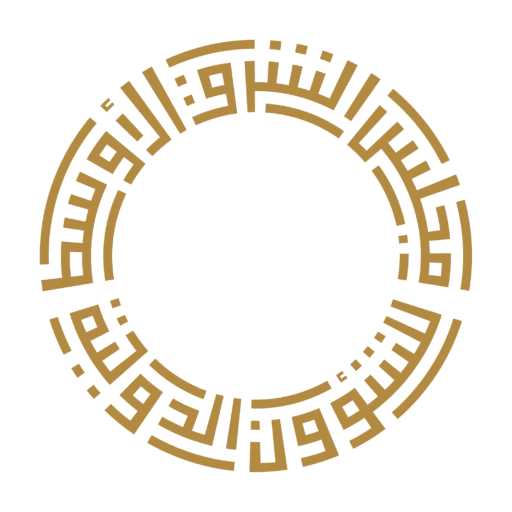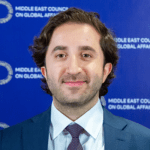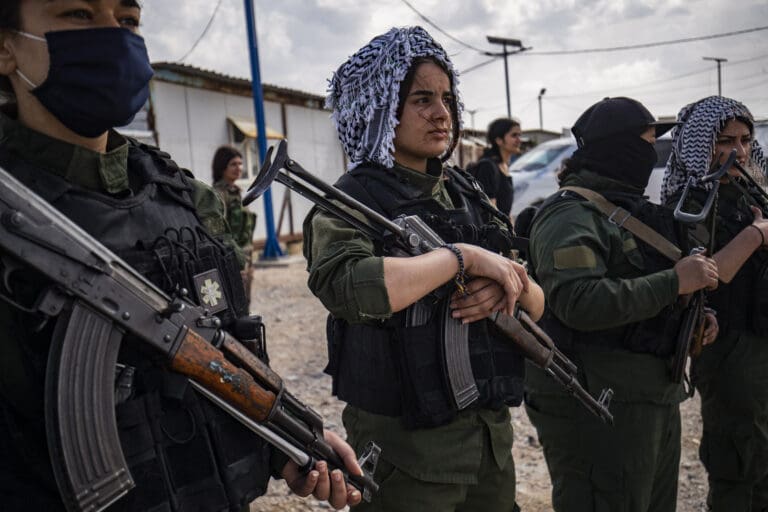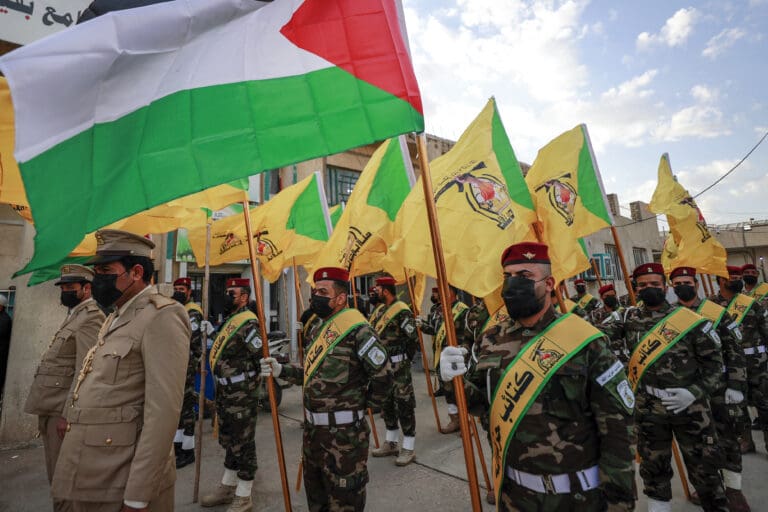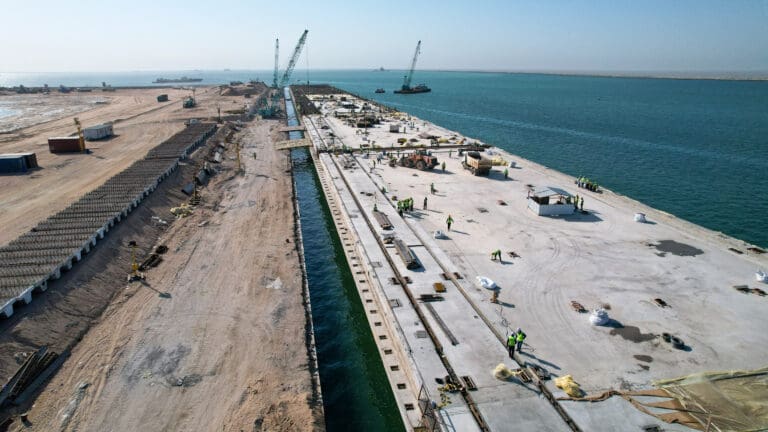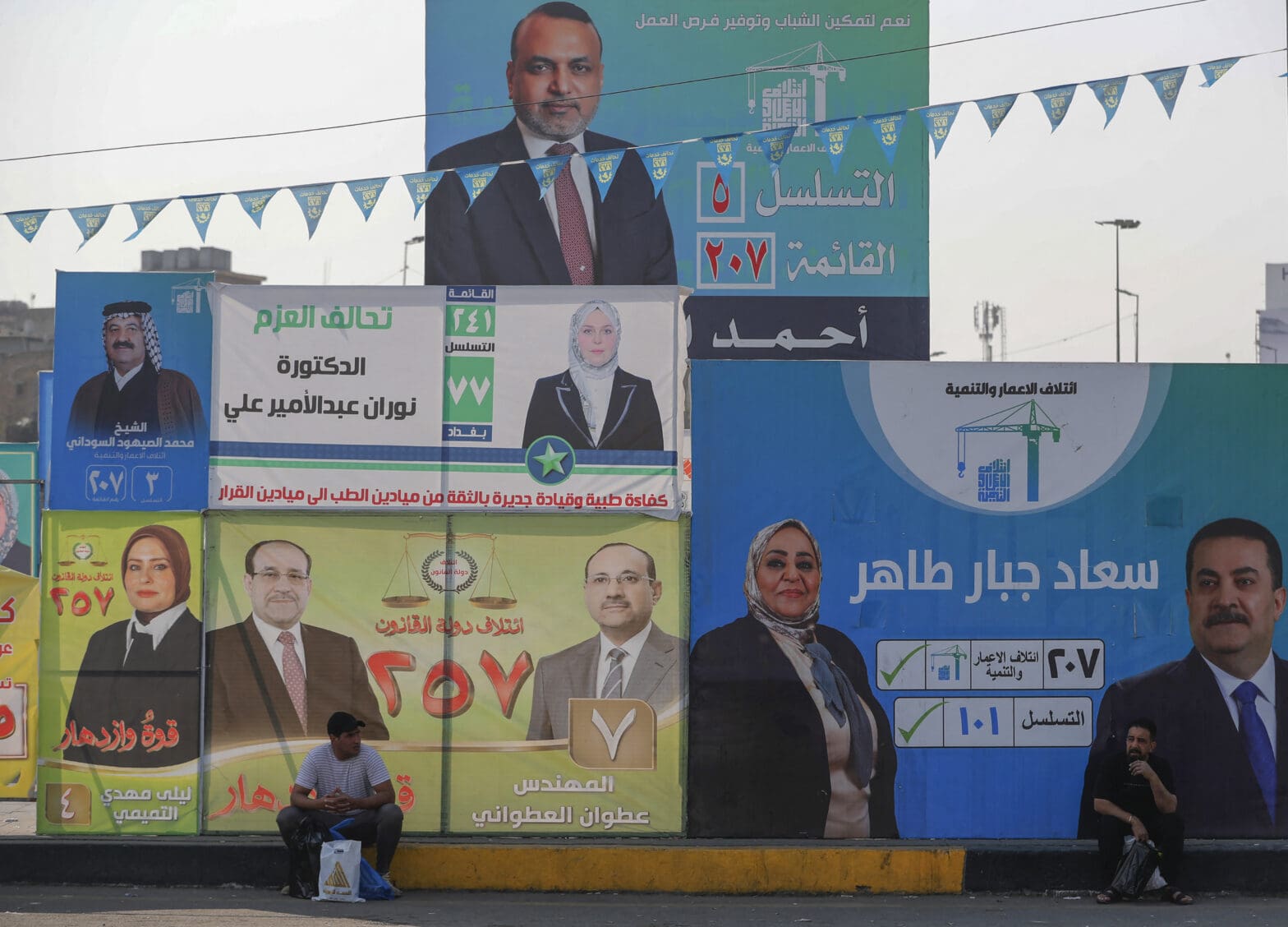
Iraq Next Chapter:
War or Consensus?
Policy Note, November 2025
On November 11, Iraqis will vote in their country’s seventh parliamentary election since the U.S.-led invasion in 2003. The election comes at a critical juncture: over the past year, the wider region has been engulfed in conflicts that have implicated Iraq, including the 12-day war in June between Israel and Iran.1 So far, despite the entanglement of the 160,000-strong, Iran-aligned Popular Mobilization Force (PMF), Iraq has managed to forestall a major war on its territory.2 While Baghdad has avoided a flare-up for now, the risk is far from over: the PMF forms part of a region-wide network of Iran-aligned armed groups that are central to the survival of the Islamic Republic.
For more than two decades, that network has played a pivotal role in fulfilling Iran’s foreign policy objectives, securing Tehran far-reaching influence in Iraq, Syria, and Yemen. Yet Israel’s expanded military campaign since late 2023 has wiped out the leadership of Lebanon’s Hezbollah and decimated its rank and file, as well as decapitating the Houthi government in Yemen.3 This campaign could now turn to the PMF, particularly if there is a sequel to the 12-day war, or if the PMF ratchets up its attacks on Israel and the United States.
In these difficult times for Iran and its severely degraded regional network of armed groups, November’s election could not be more critical to maintaining Iraq’s status as the lung through which Iran breathes. Iraq represents a vital sphere of influence for the Islamic Republic as it grapples with Israel’s military campaign, Western sanctions, and the Trump administration, which is not averse to using military force to pursue geopolitical objectives.4
This policy note examines the significance of the election for Iraq’s domestic stability, the vote’s geopolitical implications, and the future trajectory of the Iraqi state. It explains that the existing geopolitical climate inhibits Iran and its allies from deploying the violent tactics that allowed them to dominate the political landscape following the election in 2021, and how this presents an opportunity to recalibrate toward peaceful engagement. It shows that this dynamic could help forestall Iraq’s entry into a regional war, allowing for a fragile equilibrium that could let Iraq maintain and balance its relations with the U.S. and Iran, revive its economy, develop its ties to the wider region, and avoid a regional conflagration.
The PMF’s Strategic Discipline
The vote in Iraq will take place amid heightened tensions in the wider region, following a year of significant losses for Iran and its allies, including the fall of Bashar al-Assad’s regime in Syria, the elimination of Hezbollah’s leadership in Lebanon, and an ongoing military campaign against the Houthis in Yemen, which saw Israel wipe out their entire government in August. 5 Despite these losses, Iran’s allies in Iraq have emerged relatively unscathed: the PMF still retains significant influence by way of its dominance of the Iraqi parliament, control of several ministries, and influence over the judiciary.6 It was notable that during the 12-day war between Israel and Iran, the PMF adopted a muted position, despite its proximity to U.S. forces in Iraq and long track record of attacks on U.S. bases in the country.7
The strategic posture of the PMF, despite the ongoing regional escalation, reflects the maturity and discipline of an organization that has undergone a marked ascent over the past decade. Born in the crucible of the 2014 seizure of Mosul by the Islamic State group (ISIS) and Grand Ayatollah Ali al-Sistani’s fatwa mobilizing volunteers, the PMF was formed as an amalgamation of disparate militia groups. By the end of the military campaign against ISIS in 2017, it had transitioned from irregular auxiliaries into state-funded and constitutionally sanctioned members of the Iraqi armed forces.8 The organization contested the 2018 elections as a cohesive bloc and ranked second on its electoral debut.9
As an official auxiliary within the Iraqi armed forces, as well as a political organization and electoral force, the PMF has a multi-faceted position regarding the unfolding regional escalation. As a political actor, it is deeply rooted within Iraqi society, with wide-ranging patronage networks and substantial popular support.10 The PMF’s victory in the December 2023 provincial elections saw it secure 101 of 285 seats, which underscored its popularity and paved the way for increased influence as it took control of the councils that manage Iraq’s governorates, with extensive budgets and influence over local police forces.11
Economically, the PMF is a hybrid actor with one foot in the state and the other outside. It has access to a budget of more than $2.6 billion a year, while also generating billions of dollars from illicit trade and smuggling networks.12 In November 2022, the PMF established the Muhandis General Company, openly modelled on the Khatam al-Anbia conglomerate of Iran’s Islamic Revolutionary Guard Corps (IRGC). The Company was granted land along the Saudi border roughly half the size of Lebanon, and seeded with an initial operating budget approaching $70 million.13 The PMF’s combined political and economic prowess allows it to maintain and expand its patronage networks, deliver services, and swell its ranks, while widening its capacity to forge political alliances and either co-opt or instrumentalize Iraq’s institutions.
The Geopolitics of the Election
On the surface, the PMF looks poised to survive the current regional escalation. However, these are still testing and unprecedented times that could expose and widen the chinks in the organization’s armor. Domestically, the PMF has repeatedly come second to the Sadrist movement in elections, and lacks support beyond its traditional base of destitute and impoverished Iraqi Shiites, which was further weakened by its role in the 2019 crackdown on the protest movement.14
The protest movement demanded an end to Iranian influence, alongside anti-corruption reforms and better services. PMF militias, with the support of the state and guidance from Iran, killed and kidnapped thousands of civil society leaders and ordinary protestors.15 Soon after this crackdown, Grand Ayatollah Sistani denounced the PMF’s exploitation of his decree to swell its ranks. In 2020, factions aligned with the leading Shiite cleric quit the PMF over the organization’s fealty to Iran.16 These domestic and external troubles constituted the backdrop for the PMF’s poor performance in the 2021 parliamentary elections—it secured just 17 seats, a decline from the 57 it had secured in 2018, and markedly less than the 74 won by its closest rival and the poll’s winner, the Sadrist movement.17
The U.S. assassination of PMF head Abu Mahdi al-Muhandis and IRGC Quds Force head Qassem Soleimani in 2020 intensified the PMF’s internal fissures and triggered a leadership crisis.18 Yet despite this blow, the PMF’s brazen post-election maneuvering in 2021 saw it forge alliances and use violent tactics to mitigate its defeat. This included an attack on refineries in Erbil that emanated from territories controlled by the PMF.19 This culminated in its emergence as the largest post-election bloc, which played an instrumental role in the appointment of Mohammed Shia al-Sudani as the next Iraqi prime minister. As part of its post-election strategy, the PMF deployed drone attacks and political assassinations against its rivals, while Iran launched missile attacks on Erbil. 20 These tactics together enhanced the PMF’s negotiating position and torpedoed an emerging alliance comprised of the Kurdistan Democratic Party (KDP), Muqtada al-Sadr and Mohammed al-Halbousi, which would have resulted in an unprecedented cross-sectarian government that excluded the PMF.21
However, this playbook may not be viable in today’s context. That could present Iran and its allies in Iraq with a conundrum. On the one hand, the PMF could deploy its usual tactics of violence and co-option to maintain its influence in the event of a poor showing. On the other hand, the U.S. has shown it is willing to outsource aspects of its regional security strategy to Israel, which, in turn, has demonstrated a clear readiness to deploy force against Iran-aligned groups, with U.S. support.
As recently as September, Israeli Prime Minister Benjamin Netanyahu used a speech at the United Nations General Assembly to issue a direct warning to several PMF factions, placing them within the same category as Hamas, Hezbollah, the Houthis, and Iranian nuclear facilities.22 This statement came just days after the U.S. formally designated four factions within the PMF as foreign terrorist organizations.23 The U.S. has also reiterated its support for the PMF’s rivals, including the Kurdistan Regional Government (KRG).24 In addition, it has sanctioned Iraqi banks for enabling dollar leaks to Iran and for allowing the latter to circumvent sanctions; it has also threatened to sanction the Iraqi state if it continues to help Iran circumvent sanctions.25
In the past, the PMF may have been able to dismiss these developments as posturing or symbolic measures. However, when situated against Israeli operations in Lebanon, Yemen and Syria, and the Trump administration’s re-assertation of U.S. influence in Iraq, it would be a dangerous miscalculation to dismiss the notion of either a direct U.S. attack deep within Iraqi territory, or an Israeli attack backed by Washington.
Domestic Pressures and the PMF
The November’s election and its aftermath will also have long-term domestic implications. The relationship between the Iraqi state and society has taken a hit in recent years, with millions of Iraqis disenchanted and disenfranchised as a result of poor governance, corruption and authoritarian rule.26Iraq faces major socio-economic challenges as a result of a youth bulge, economic degradation, and dilapidated infrastructure. The country’s population of more than 45 million is expected to reach 50 million in a decade.27 More than 60% of Iraqis are under 24, and 400,000 graduates seek to enter the job market each year.28
To compound these challenges, the Iraqi state and the post-2003 political order is in the midst of a legitimacy crisis because of the ruling elites’ failure to address the demands and grievances of the population, as expressed by the Tishreen protests, which sought a complete overhaul of the post-2003 political order.
Disillusionment is reflected in the declining voter turnout. In 2005, participation reached nearly 80 percent, symbolizing optimism in the country’s democratic transition. Yet enthusiasm has collapsed over time, with turnout falling to 45 percent in 2018 and 36 percent in 2021. The real numbers are reported to be even lower.
The Tishreen movement evolved and transitioned into an electoral force known the Imtidad Movement, which secured nine seats in the previous elections, working with actors in wider civil society who continue to advocate for good governance and reforms.29 However, Iraq’s political system is built to resist significant reform. A complex network of official and unofficial, state and non-state actors controls and influences the country’s power structures. Iraq is plagued by the unchecked spread of weapons and armed factions, a lack of effective institutions, and the presence of competing power centers that often override the authority of the state. In many regions, the government has little control, with power fragmented among political parties, militias, tribal leaders, and religious figures.
In addition, the deep-rooted issues that paved the way for the failed uprising in 2019 remain, as do additional grievances emanating from the PMF’s state-backed violent crackdown, which saw 550 protesters shot dead, thousands injured and hundreds detained or kidnapped.30 Looking ahead to the November elections, the trajectory of Iraq’s protest movement and the future of the post-2003 political order will hinge in no small part on the choices made by Muqtada al-Sadr. Sadr commands not only Iraq’s most powerful socio-political movement but also a political bloc that has won the country’s last two parliamentary elections.
In 2020, in response to the repression of the protests, Sadr distanced himself from the Shiite Coordination Framework and the wider Shiite political class, who had unified their ranks in response to the protests. Yet Sadr’s subsequent withdrawal of support for the demonstrators dealt them a serious setback, underscoring their vulnerabilities (and Sadr’s unreliability).
There are open questions over how Sadr intends to position himself in the coming electoral contest, and whether he will once again call for mass mobilization as a means of exerting pressure on his rivals. Although Sadr has called for a boycott, the cleric could attempt to re-engage the protest movement in a bid to upend or mitigate the status quo, framing himself as its protector while simultaneously incorporating its demands into his broader populist agenda. Such an alignment would provide the demonstrators with both political cover and physical protection, given Sadr’s ability to mobilize armed elements as well as popular support. However, this would come at the cost of their independence, risking co-optation into Sadr’s political project rather than advancing their own agenda of systemic reform.
Alternatively, Sadr might belatedly decide to contest the election and then move to develop an alliance with Imtidad, which would create a buffer between the protestors and state-aligned militias within the PMF. This could be particularly important if the election is contentious as a result of fraud or low turnout. Here, domestic tensions could combine with regional ones to create an environment in which the PMF and its allies crack down on civil society and protestors under the pretext of regional conflicts—as per the playbook deployed by Iran-aligned groups in 2020.
Achieving an Equilibrium
November’s election could pave the way for tumult and conflict in Iraq, including a revival of the Tishreen protest movement and a repeat of the clashes that unfolded between the Sadrists and the PMF in the aftermath of the previous vote.31 This time around, the PMF could be engaged in multiple contestations, including against its closest rival the Sadrists, a potentially revived protest movement, and finally Israel and the U.S., who may see post-election violence by the PMF as an opportunity to target the organization’s leadership and infrastructure. In addition, the PMF’s patron, the Islamic Republic, has been severely weakened.
These factors suggest the PMF lacks the space in which to engage its rivals using the tactics it has deployed in the past. But rather than push the organization into a corner, there could be an opportunity for Iraq to correct course, establishing itself as a neutral actor that balances its relationships with Iran and the U.S., and focusing its attention on good governance, rather than on Iran’s conflicts.
The PMF, therefore, has an opportunity to recalibrate, moving toward peaceful engagement with its rivals to forestall its entry into a war that could result in untold losses both for itself and for Iraq. The November election is a referendum less on parties than on pathways. One pathway leads to the consolidation of a hybrid order as the PMF clings to influence regardless of the costs it brings to the state and society, even to the point of a war within Iraqi territory. The other leads to a fragile equilibrium and a peace that sees Iraq maintain and balance its relations with both the U.S. and Iran, allowing it to revive its economy, develop its ties to the wider region, and avoid a regional conflagration.
Endnotes
1 Adrian Blomfield, “Mass assassinations to bunker-busters: the 12 days that reshaped the world,” The Telegraph, June 25, 2025, https://www.telegraph.co.uk/world-news/2025/06/24/iran-israel-12-day-war-that-shook-world/.
2 “Popular Mobilization Commission (PMC) in Iraq adopts Code of Conduct for Humanitarian Norms”, Geneva Call, December 22, 2022, https://www.genevacall.org/news/popular-mobilization-commission-pmc-in-iraq-adopts-code-of-conduct-for-humanitarian-norms/.
3 Jaroslav Lukiv, “Houthis confirm their prime minister killed in Israeli strike”, BBC News, August 30, 2025, https://www.bbc.co.uk/news/articles/c620ykrxedwo.
4 Muhanad Seloom, “From Rivals to Allies: Iran’s Evolving Role in Iraq’s Geopolitics,” in Iran in the Middle East: Building Bridges or Expanding Influence? (Doha: Middle East Council on Global Affairs, April 19, 2024), https://mecouncil.org/publication_chapters/from-rivals-to-allies-irans-evolving-role-in-iraqs-geopolitics/.
5 “Bashar al-Assad: Sudden downfall ends decades of family’s iron rule,” BBC News, December 9, 2024, https://www.bbc.co.uk/news/10338256 ; “One year after killing of leader Nasrallah, Hezbollah says no to disarming,” Al Jazeera, September 28, 2025, https://www.aljazeera.com/news/2025/9/28/one-year-after-killing-of-leader-nasrallah-hezbollah-says-no-to-disarming.
6 Michael Knights, Hamdi Malik, and Aymenn Jawad Al-Tamimi, Honored, Not Contained: The Future of Iraq’s Popular Mobilization Forces, Policy Focus 163. (Washington, D.C.:The Washington Institute for Near East Policy, May 23, 2020), https://www.washingtoninstitute.org/policy-analysis/honored-not-contained-future-iraqs-popular-mobilization-forces.
7 Knights, Malik & Al Tamimi, Honored, Not Contained, 163.
8 Ahmad Majidyar, Iran-backed militia groups will receive full military benefits under new decree, (Washington, D.C.: Middle East Institute, March 9, 2018), https://www.mei.edu/publications/iran-backed-militia-groups-will-receive-full-military-benefits-under-new-decree.
9 “Iraq elections final results: Sadr’s bloc wins parliamentary poll,” Al Jazeera, May 20, 2018, https://www.aljazeera.com/news/2018/5/20/iraq-elections-final-results-sadrs-bloc-wins-parliamentary-poll.
10 Majidyar, Iran-backed militia groups will receive full military benefits under new decree.
11 “Iraq’s governing Shia alliance strengthened in provincial elections,” Al Jazeera, December 20, 2023, https://www.aljazeera.com/news/2023/12/20/iraqs-ruling-shia-alliance-tops-provincial-elections.
12 Amir al-Kaabi and Michael Knights, Extraordinary Popular Mobilization Force Expansion, by the Numbers, (Washington, D.C.:The Washington Institute for Near East Policy, 3 June 2023), https://www.washingtoninstitute.org/policy-analysis/extraordinary-popular-mobilization-force-expansion-numbers ; Laura Adal and Sarah Fares, “Smuggling, subsidies and shortages: Iraq’s latest oil troubles,” Global Initiative Against Transnational Organized Crime, February 10, 2023, https://globalinitiative.net/analysis/iraq-oil-smuggling/.
13 Amir al-Kaabi and Michael Knights, Extraordinary Popular Mobilization Force Expansion, by the Numbers, Policy Analysis. (Washington, D.C.:The Washington Institute for Near East Policy, June 3, 2023), https://www.washingtoninstitute.org/policy-analysis/extraordinary-popular-mobilization-force-expansion-numbers
14 Ranj Alaaldin, “The Origins and Ascendancy of Iraq’s Shiite Militias,” Current Trends in Islamist Ideology, November 1, 2017, https://www.hudson.org/national-security-defense/the-origins-and-ascendancy-of-iraq-s-shiite-militias.
15 “Iraq: Protest death toll surges as security forces resume brutal repression”,” Amnesty International, January 23, 2020, https://www.amnesty.org/en/latest/news/2020/01/iraq-protest-death-toll-surges-as-security-forces-resume-brutal-repression/.
16 Mustafa Saadoun, “Shiite factions close to Sistani move to separate from Iran-backed militias,” Al-Monitor, May 18, 2020, https://www.al-monitor.com/originals/2020/12/iraq-iran-pmu-sistani.html.
17 “Final results confirm Sadr’s victory in last month’s Iraqi vote,” Reuters, November 30, 2021, https://www.reuters.com/world/middle-east/final-results-show-cleric-sadr-won-iraq-vote-state-media-says-2021-11-30/.
18 Gareth Browne and Zaheena Rasheed, “‘Perilous times’ for Iraq’s Shia militias after Soleimani killing,” Al Jazeera, January 22, 2020, https://www.aljazeera.com/features/2020/1/22/perilous-times-for-iraqs-shia-militias-after-soleimani-killing.
19 “Missile Attack Causes Fire in Iraqi Oil Refinery: Officials,” Al Jazeera, May 2, 2022, https://www.aljazeera.com/news/2022/5/2/missile-attack-causes-fire-erbil-oil-refinery-officials ; “A Thousand Hezbollahs: Iraq’s Emerging Militia State”, New Lines Institute, 4 May 2021, https://newlinesinstitute.org/nonstate-actors/a-thousand-hezbollahs-iraqs-emerging-militia-state/.
20 Mohanad Faris, “The Popular Mobilization Forces in Iraq: A Political Bargaining Chip?”, The Washington Institute for Near East Policy, Fikra Forum, April 8, 2022, https://www.washingtoninstitute.org/policy-analysis/popular-mobilization-forces-iraq-political-bargaining-chip ;
21 Renad Mansour, “The Political Logic behind Iraq’s Fragmented Armed Forces” Middle East Research and Information Project, April 4, 2023, https://www.merip.org/2023/04/the-political-logic-behind-iraqs-fragmented-armed-forces/.
22 “Netanyahu Threatens to Destroy Iraqi Militias Leaders in Fiery UN Address,” Kurdistan 24, September 26, 2025, https://www.kurdistan24.net/en/story/865896/netanyahu-threatens-to-destroy-iraqi-militias-leaders-in-fiery-un-address ; “US lists 4 Iran-backed Iraqi militias as foreign terrorist organizations”, Al Monitor, September 17, 2025, https://www.al-monitor.com/originals/2025/09/us-lists-4-iran-backed-iraqi-militias-foreign-terrorist-organizations.
23 “US designates four Iran-aligned militias as terrorist organizations,” Reuters, September 17, 2025, https://www.reuters.com/world/middle-east/us-designates-four-iran-aligned-militias-terrorist-organizations-2025-09-17.
24 Mohammed Salih, “The Multi-Billion Dollar Relationship: The New Chapter in Kurdistan-U.S. Relations,” MEPS Forum, 26 May, 2025, https://www.mepsforum.org/post/the-multi-billion-dollar-relationship-the-new-chapter-in-kurdistan-u-s-relations.
25 U.S. Department of the Treasury, “U.S. Treasury Takes Action to Protect Iraqi Financial System From Abuse,” press release, January 29, 2024, https://home.treasury.gov/news/press-releases/jy2053.
26 “Iraq’s Rafidain Bank pushes back amid US accusations,” Rudaw, August 19, 2025, https://www.rudaw.net/english/middleeast/iraq/19082025.
27 Qassim Abdul-Zahra, “46.1 million people were counted in Iraq’s first census in nearly 40 years,” AP News, February 25, 2025, https://apnews.com/article/iraq-census-final-count-45b7753ddc82c188c79faea0d5a8c90d ; “Iraq population projected to hit 50 million by 2030,” Kurdistan24, September 18, 2021, https://www.kurdistan24.net/en/story/385597.
28 Amna Haider and Mahnaz Vahdati, “Reimagining a way forward: Iraq’s economy and energy sector in the post-invasion era,” (Washington, D.C.: Atlantic Council, May 9, 2023), https://www.atlanticcouncil.org/uncategorized/reimagining-a-way-forward-iraqs-economy-and-energy-sector-in-the-post-invasion-era/.
29 Taif Alkhudary, “Fragmentation of Iraq’s ‘Protest Parties’ amid the Muhasasa System’s Resilience,” PeaceRep, October 14, 2022, https://peacerep.org/2022/10/14/fragmentation-iraq-protest-parties-muhasasa/.
30 Amnesty International, “Iraq: Protest death toll surges.”
31 John Davison and Haider Kadhim, “Deadly clashes rage in Baghdad in Shi’ite power struggle,” Reuters, August 30, 2022, https://www.reuters.com/world/middle-east/iraqi-cleric-sadr-announces-full-withdrawal-political-life-twitter-2022-08-29/.
